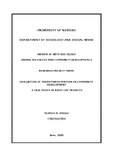Evaluation of youth participation in community development a case study of Kaiti CDF projects
Abstract
This study was undertaken with the aim of evaluating youth participation in community
development in Kaiti CDF projects. The specific objectives of the study were to: establish the
various ways and levels of youth participation in the CDF activities and projects; ascertain the
factors (opportunities) that facilitate youth participation in CDF funded projects in Kaiti
Constituency; elucidate the constraints that youth face in their efforts to participate in local
community projects funded by the CDF and to establish existing methods of meeting the
needs of youth at the Constituency level through their participation in the CDF funded
projects.
The study population was drawn from the youth in the constituency out of whom 100
respondents were selected. The selection was through a purposive sampling technique to
sample the youths that could be reached and were able to participate in the study. Both
primary and secondary data were used in the study. Interviews and Focused Group
Discussions were the data collection tools employed for the youth groups whereas in-depth
interviewing was employed for key informants like the area MP, CDC members, and
Provincial Administration representatives, Teachers, the DDO, District Statistical Officer and
Church Pastors. The collected data was analysed through SPSS software for data analysis.
The study findings revealed that youth participation in CDF projects in Kaiti constituency was
very low. Further they also showed that youth awareness on the CDF was misleading, as a
cumulative 22.4 % had either the wrong notions or no clue on what the CDF represents, hence
a need for sensitization on the key role the CDF could play in meeting youth needs and
empowerment programmes. Youth were basically involved in projects that utilized their
physical energies like road construction and no specific projects that addressed youth needs
like recreational or job creating projects like farm projects or small and medium enterprises
existed.
Therefore the researcher recommends that Kaiti Constituency adopts Katorobo‟s mass model
of participation which advocates for increased youth participation. Priority should be given to
the youth in increasing participation employment-creating projects so as to encourage their
involvement in the projects. It further recommends a critical analysis of the needs of the Kaiti
Constituency youths, ensuring equal gender representation and including the right ages that
can and have the time and need to actively participate in CDF activities and finally a study in
the correlation between information dissemination and participation in development activities.
Publisher
University of Nairobi
Description
Thesis

